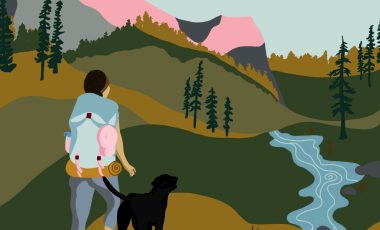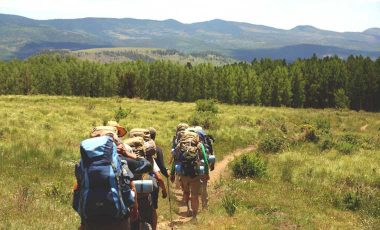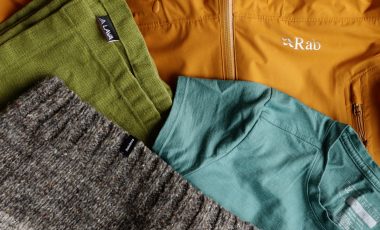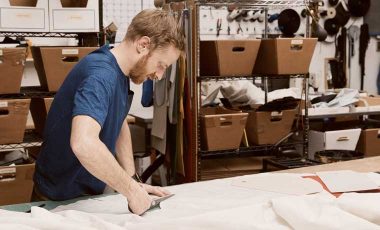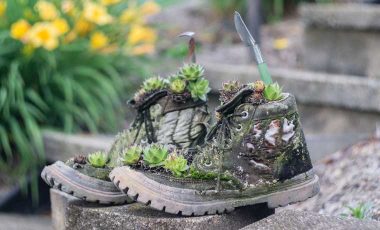Meg Carney, one of our contributing writers, has published a book! But not just any old book about having a lovely time outside. Outdoor Minimalist is a guide to getting the best out of outdoor adventures but in a low impact way, environmentally. Something EVERY outdoors person can most certainly benefit from, and we’re delighted to share an excerpt from it for you to enjoy.
Get To Know Your Gear
No matter the pursuit, any outdoor enthusiast can attest to the importance of quality outdoor equipment. Over time, the quality and quantity of gear available has drastically changed. How do you shop effectively when the options for outdoor equipment are practically endless and new gear is released daily? Faced with overwhelming choices, most of us default to the cheapest option or the brands we know.
As you implement zero-waste or minimalist approaches to your various outdoor activities, one of the best places to start is with your gear. Outdoor gear can be a lot of things. For someone who hikes, it could be their backpack, water bottle, hiking shoes, or sun hat. For someone who kayaks, their gear may include their kayak, paddle, life jacket, sunglasses, or splash skirt. For a climber, it’s likely safety equipment like a harness, ropes, cams, stoppers, and slings. Outdoor gear is somewhat unique to the particular outdoor pursuit you are undertaking, but it can essentially be defined as the physical items that allow you to safely engage in the outdoor activities you enjoy.
There is some extensive pressure within many sectors of the outdoor industry to have “all the right” or “all the best” gear for every pursuit. Beginners (which we all are at some point) in an outdoor activity often turn to online resources to gather information about the gear and knowledge we need. The internet is an excellent resource for these types of questions, but it can also overwhelm your selection process and what you deem as necessary versus what you actually need to be successful in that particular activity.
Unfortunately, we don’t actually need most of the gear that is marketed to us. We are just told that we should have it or at least we should want it—it all goes back to the general culture of consumerism. Narrowing down the gear you really need may seem daunting at first, because it is, especially if you are just getting into a new outdoor activity. Needs vary with skill, and outdoor equipment often becomes more about comfort.
To understand this section of the book, let’s learn know how to approach outdoor gear with a minimalist mindset in a few easy steps:
Evaluate and identify the gear you need to be safe during your outdoor activities.
- Once you know what you need, start with what you have. If you don’t have anything, then ask friends and family if they’d be willing to either lend or give you old gear that is still functional. When that’s not an option, choose to buy secondhand equipment or rent gear from an outfitter.
- Start to understand a product’s entire life cycle, not just its life with you, before investing in new gear.
All of these steps help you start on the right path of outdoor minimalist gear selection, but your knowledge of the gear itself is also vital during your selection process.
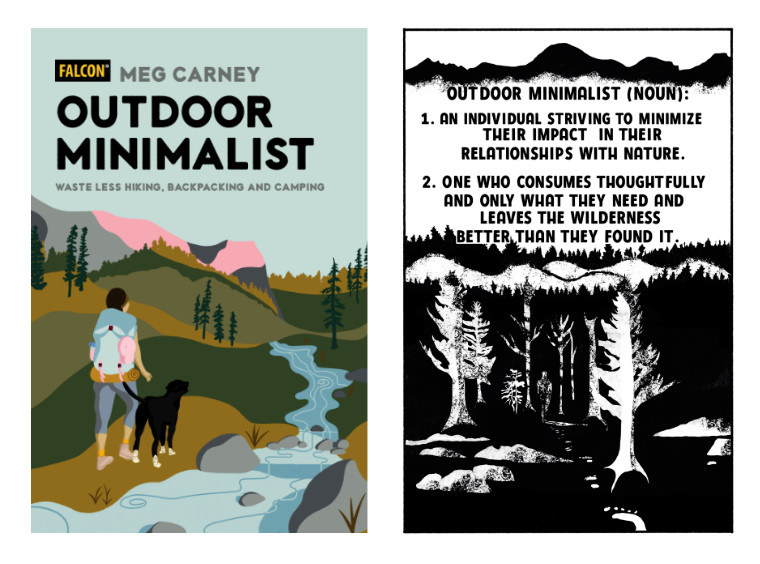
Image credit: Falcon Guides
How Do You Know What Outdoor Gear You Actually Need?
Many of us never even learn to identify actual needs. Consumer culture blurs the lines between wants and needs, encouraging us to buy more and more. When applying need vs. want to outdoor minimalism, it can be difficult to know where to start, especially if you are new to an activity.
To identify needs in terms of outdoor recreation, you will need to separate them from your basic human needs of food, shelter, and safety. Once those basic needs are met, then you can branch into secondary needs regarding the types of outdoor gear. Beyond your basic human needs for survival, needs can apply to your requirements for physical and mental wellness. While this can feel like it is blurring the lines between needs and wants, consider that your personal needs can be applied to any type of relationship, including your relationship to self, consumerism, and inanimate objects like gear.
To help guide you through the process of identifying your needs when it comes to outdoor gear, I’ve chosen four primary areas of consideration:
Price
- Quality
- Safety
- Sustainability
There will be overlap between some of these, but dissecting the decision-making process into four distinct areas can help narrow down purchase options as well as dictate the difference between desires and needs.
Price
The first aspect of deciding which gear you need is going to come down to your budget. In a sense, having less money budgeted for outdoor gear and recreational activities is a form of forced minimalism. If you can’t always afford the nicest and the newest gear, you are going to invest your money in what you actually need.
After all, you put your energy into earning money, and that money then becomes energy for investing in other life needs.
So the price of an item becomes a driving force in the need or want of an item, especially one you have to save and budget to buy. As an example, before I bought my beloved gravel bike (named Meriwether because I know you needed that information), I knew it was going to be an expensive investment. And I used the word investment over purchase, because when the outdoor gear you buy is viewed as an investment versus a purchase, you value it more. A purchase is more closely related to instant gratification, because it is a one-time thing. When you purchase something, you spend your money and then it is gone, whereas an investment is putting your money into something that will yield more results and add value in the long term.
In the grand scheme of life and my basic human needs, did I need a gravel bike? No. I wanted a gravel bike, but I knew that a quality and reliable bike would contribute to my mental, physical, and spiritual happiness—not to mention help cut down motorized travel. In that context, I decided it was a worthwhile investment, and it also falls into the parameters of a personal need as it adds value to my life. With that information, I then decided to pool my energy into making and saving money to invest in a gravel bike. I did not want to rush out to Walmart to buy a bike for a couple hundred dollars. Not only would that cheaper bike likely not last me longer than a year, but I would be putting my money into an unsustainable production model that values profit over resource management and environmental health. I did my research, talked to experienced gravel cyclists, and focused my search on used bikes, allowing me to get a bike of better quality within my price range.
Your budget and the price of items can impact how you perceive personal needs. High-quality gear may be more difficult to find, but that should not diminish the importance of meeting your gear needs. In fact, having to save money to buy outdoor gear can enhance your perceived investment and add more value to your gear in the long run. Price can sometimes dictate the availability of what you can realistically afford, but it does not need to minimize your needs. You just might have to take a different approach.
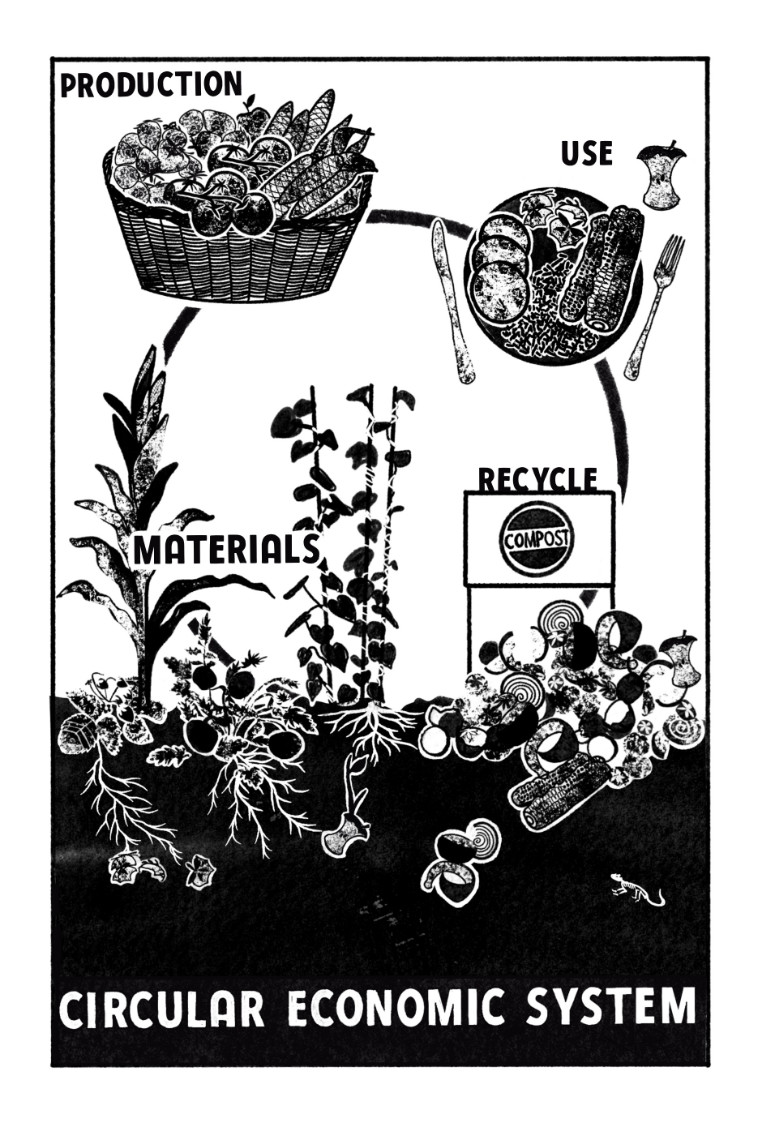
Image credit: Falcon Guides
Quality (and frequency of use)
In a perfect world, we’d always buy the highest-quality gear, no exceptions. That is not a realistic expectation, though, because we do not all have the same resources or even the same interest level in an activity. For instance, I invested heavily in my bike because I love cycling, have for a long time, and know I will continue well into the future. I wouldn’t suggest spending $2,000 on a bike for your toddler who’ll outgrow it in months or for a casual cycler who bikes a few times a year. Your level of investment in an activity can also impact your level of investment in the quality of equipment.
For many of us, price is going to be and will continue to be the driving force in our purchasing decisions. We also know that we often have to pay more to get a higher-quality item, but if we are willing to pay more, that item will likely last us far longer, making the initial investment worth it in the long run. For the purposes of deciding your needs when it comes to outdoor equipment, quality should be a consideration because you not only want something that works for you but also want it to last through the trials of use.
You might want the very best bike because it’s shiny and prestigious, but do you really need it if you only ever bike around your neighborhood? Quality is important, but we need to learn to distinguish between actual value and consumer cachet.
Safety
The next most common consideration when it comes to the need of outdoor equipment is if it improves your level of safety when participating in a particular activity. As mentioned earlier, our experience level in the outdoors and within that activity can drastically change the type and amount of gear necessary for you to be safe in that environment. For instance, I would never tell a first-time backpacker to go ultralight or pursue bushcraft on their own. Those skills take time to cultivate and although you can learn by jumping into the fire, there are far too many deadly situations that could have been prevented by having more knowledge of that environment, your skill level, and the correct equipment.
If a piece of equipment that you use helps you stay safe in the backcountry, I’d qualify that as a need. Even if someone more experienced may not be carrying it or even says it isn’t necessary, they are not you, and they do not have the same knowledge base as you. It is imperative to not compare yourself to others when engaging in outdoor recreational activities, because more often than not, you will get yourself into a situation that you are not prepared to handle.
So, when deciding if you need a piece of equipment, first consider if it increases your level of safety. Comfort is a secondary concern.
Sustainability
As you analyze your needs when it comes to outdoor gear, sustainability should become a part of the larger picture. The quality of your gear is often reflected by the materials they are made out of, and those materials in many instances are not sustainable or environmentally friendly. We are starting to see a shift, especially in the outdoor industry, as companies make more of an effort to produce sustainable products, but with certain industry and consumer standards it is difficult to always meet those expectations.
So, unfortunately, when you are looking at your needs when it comes to gear, sustainability is often put last when it should be first. However, sustainability does not always need to be associated with environmental impact. For gear purposes, sustainability can also mean how sustainable it is for you to continue to use that item for its intended use. This can then tie back to frequency of use. Back to the bike example: If cycling does not fit your lifestyle and you wouldn’t consistently use a bike, it would not be a sustainable purchase. The word sustainable is defined as, “able to maintain at a certain rate or level.” With that definition in mind, consider whether or not you can sustain a lifestyle that utilizes gear effectively before making a purchase. If you can’t, then you probably don’t need it.
There are times when you may not know if you are going to like an activity or not yet, but you want to try it out. In those instances, you may not know how often you will ultimately engage in that activity. In this scenario, the best approach would be to rent or borrow equipment so you can try the activity for a short time. Then, if you enjoy it, you can invest in gear appropriate for you.
Thanks to Meg Carney for this sneaky peek at her new book: Outdoor Minimalist: Waste Less Hiking, Backpacking, and Camping.


